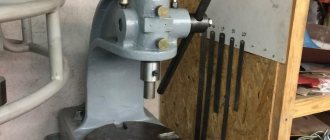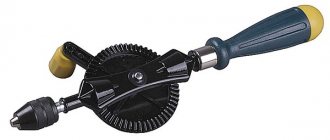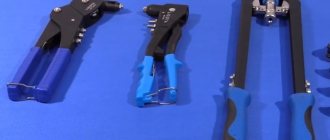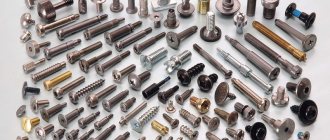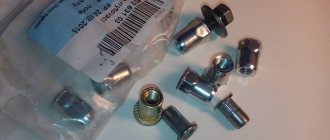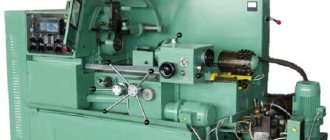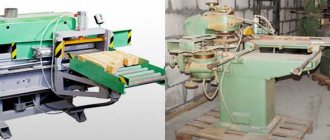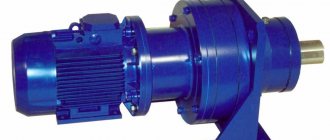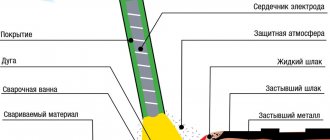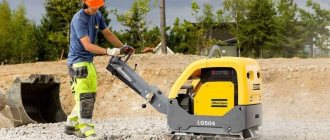The connection of thin sheets of metal, wood, various synthetic materials and even dense fabrics is often done with rivets, which require a special tool - a riveter.
Mechanical options have become widespread both in everyday life and in professional activities due to ease of use and relatively low cost.
At the same time, a battery-powered or pneumatic riveter is more productive.
The rivet joints themselves have a number of advantages over similar ones, including vibration resistance and increased strength.
As soon as the load exceeds the permissible value, the rivet stretches before breaking. But first things first.
What is a manual riveter
Riveters are these types of hand tools that are used to connect two metal workpieces up to 10 mm thick. The main purpose of the tool is to provide a permanent connection of sheet metal. The connection of metal sheets occurs through the through-mounting method. This tool is used when it is impossible to use welding and threaded connectors. Structurally, the tool has the shape of pliers and consists of the following components:
- Handle - sets the mechanism in motion by applying physical force of a person
- Clamping mechanism, which comes in two types - pull-out and threaded
- Head - the fixing part on which the consumable element is attached
This is a simple device that allows you to quickly and permanently connect sheet metal. Riveters are not only manual, but also pneumatic, electric and battery-powered, but the first type of tool is more popular. This is due to a number of advantages, the main ones being affordable price, ease of use and no need to use additional equipment.
Pneumatic, electric and battery-powered devices are more expensive and are intended to be operated by specialists. The main advantage of pneumatic, electric and battery-powered devices is that they do all the work, so the operator does not need to exert any effort. The relevance of their use arises in the case of using large diameter rivets.
This is interesting!
Manual riveters are also called riveters. They come in two types, and to find out what differences they have, let’s look at their parameters.
What types are there?
Electric, battery, pneumatic.
However, they are not as popular as manual ones. The point is that it's overpriced. And although they essentially do all the work for you, buyers are still not ready to go completely electric.
The manual riveter is more understandable to people. It is easy to use and affordable.
The first three types are more suitable for avid specialists.
Or in the case when large diameter rivets are used.
Threaded riveter or nut riveter - its pros and cons
This is a special type of riveter, which is designed to work with threaded rivets. This type of tool provides a more reliable connection, and also allows it to be further strengthened through the use of bolts. The threaded connection ends up being permanent. The hole after the connection has an internal thread. The operating principle of threaded riveters is based on the fact that a threaded rivet is screwed onto the tool head (rod or threaded part). After this, a rivet attached to the tool is inserted into the hole, and the handles are compressed. When the handles are compressed, creasing or flaring occurs on the opposite side of the riveting, resulting in the formation of a head.
The design of the threaded riveter is shown in the photo. This type of tool is classified as powerful, and therefore the larger the size of the rivet, the more effort the operator must exert to make the connection. The advantages of such devices include high quality connections, which can be strengthened with a bolted element. In addition, the advantage is the ability to use rivets of different sizes, which also affects the quality of the connection. Such instruments have more disadvantages, and they manifest themselves due to the following factors:
- High cost of the tool: more than 2,500 thousand rubles
- The need to apply great physical effort, which increases depending on the diameter of the riveting
- Low connection speed, since the rivet must first be screwed onto the threaded tip of the tool, and after connection, the device must be unscrewed
- The high cost of not only the tool, but also the rivets
It is rational to choose a threaded riveter only when it is necessary to ensure a reliable connection of sheet steel, as well as in the presence of large diameter holes. The presence of holes at the joints allows the resulting structure to be fastened.
Varieties
The difference between rivets of this type lies not only in their diameter, but also in other parameters, one of which is the metal of manufacture. The following can be used as a basis:
Each of these metals has its own advantages over others. Regular steel rivets are most often coated with zinc to prevent rust during use. In this regard, stainless steel products benefit, but their cost is slightly higher. They also have greater strength. Copper and aluminum are used in cases where interaction with a similar metal is required, and the rivet will not hold a module that is too heavy. Each element has a head that guarantees fixation on the front side. It can be flat or hidden. The second option will require widening the outer diameter of the hole to hide the sides. Blind rivets are used most often in case of one-sided installation. The latter is carried out in a situation where the thickness of the metal of the workpiece is greater than the rivet and the latter does not have the opportunity to fully compress it. In this embodiment, fixation occurs due to the expansion of the element body inside the hole.
Mounted modules have different pitches and thread diameters, so products are required to match them. That is why companies producing such fasteners are most often ready to provide their customers with rivets that have a diameter from M4 to M8. This applies to nut structures when there is no access to the reverse side of the metal. There is also a collapsible screw type, which is available in sizes from M3 to M16. The cut profile of the product may also be different. Most often, round is used, but hexagonal can also be used. In the second case, making a hole for such a unit requires some effort, but turning it is much more difficult, and in some cases impossible, when compared with the round version.
Threaded rivets can be specialized, so depending on the application, they may have reduced resistance to electrical current. Other elements have increased strength, because they are designed to work under heavy loads. Depending on the shape, the clamps are able to provide a tight connection. The heads of some elements have special marks that allow them to be identified among other products. Vibration-isolating rivets are often used in automobiles. Especially when it comes to mounting on body parts.
Exhaust view of the riveter - what is it?
This is a tool whose operating principle is similar to threaded ones, only instead of a threaded rod tip, a cylindrical pin is used. These studs are mounted on rivets. The rivet is inserted into the tool hole and then positioned into the pre-drilled hole in the sheet stock. Impact on the tool handles leads to crushing of the rivet on the reverse side by pulling the pin outward. The pin is pulled out and a riveted joint is obtained.
The advantages of exhaust riveters include:
- Low cost, unlike threaded ones
- High speed of work completion
- Easy to install
- It turns out a secret connection
The only disadvantage can be considered that in this way it is impossible to connect sheet steel in which large-diameter holes are made. Such tools are intended for joining sheet metal with hole diameters up to 7 mm.
DIY riveter
In some work situations, when you have to deal with large diameter fasteners, the power of a conventional hand tool is not always enough. You can get out of this situation if you make a manual riveter with your own hands in advance, taking into account frequently encountered tasks. As a basis for this device, you can use a steel bolt of the same cross-section as the rivet.
You should hang a nut on it, and then put a small thrust ball bearing on top. This piece will help ensure that pressure is evenly distributed when the tool applies force to the rivet and will also help prevent the nut from seizing. When assembling a homemade manual riveter, be sure to put a couple of washers between the fastener and the bearing, to correctly calculate the number of which you should focus on the depth of penetration of the fastener into the material.
Installation of fasteners using a homemade rivet gun is performed according to the following algorithm:
- First, the tool must be aligned with a hole of the required diameter, and then, holding the nut with one key, unscrew the screw head with another key.
- Under the influence of the force that forces the bolt to leave the surface being fastened, the rivet will be deformed, making it easy for it to take the correct position in the seat.
This method of installing fasteners should be resorted to only when the master does not have enough time or resources to purchase a branded tool for threaded rivets. A homemade riveter has only one significant drawback - during operation, the bolt can jam inside the fastener. Most often this occurs due to excessive pressure on the tool handle or the surface of the bolt material being too soft. Therefore, it costs nothing to cut off such a thread with a harder nut.
If you have the opportunity to use lathes, you can try making an improved version of a mechanical riveter. This version of the tool looks like a bolt with threads of different diameters. A lever of a certain length must be placed in a head with a through hole so that the tool can be securely fixed. Be sure to put a wide washer between the clamping nut and the rivet.
As in the previous case, the washer is needed here in order to ensure uniform pressure distribution. The main advantage of such a homemade riveter is that the clamping nut can move along a large diameter bolt, which is more reliable in contrast to M2-M4 size fasteners, and this will prevent the occurrence of deformation.
Home craftsmen who regularly have to perform various types of household work should have a lot of different tools in their arsenal. Among them should be a riveter, with which you can create reliable connections with minimal effort.
But to ensure proper connection of the elements, it is necessary to correctly select not only the rivet tool, but also the rivets for it. After all, the manual version of the tool is able to provide a reliable connection only when using aluminum or copper rivets, which few people know about. It is also necessary to ensure that the manual riveter has sufficient power and can effectively perform its main task.
Sometimes, when problems arise with this, some home craftsmen begin to think about making this tool with their own hands. Although this approach to solving the problem that has arisen can be considered, sometimes during the installation of fasteners the bolt, which is the main working unit of a homemade riveter, can jam. Therefore, it is not recommended to use such a tool constantly.
Types of tools by number of handles: one-handed and two-handed
In addition to the fact that riveters come in threaded and pull-out types, they also differ in the number of handles - one-handed and two-handed. A one-handed riveter is considered to be a tool in which one handle is movable and the other is fixed.
These are often exhaust devices that do not require much effort. They are designed for connecting rivets with a diameter of up to 6.4 mm.
Two-handed riveters are devices in which both handles are movable.
These are often threaded-type models, which require a lot of physical effort. They allow for riveted connections using rivets with a diameter of up to 14 mm.
Accordion riveters are a special type of tool that consists of one handle connected to a pressing mechanism in the form of an accordion or toad.
Such a tool also belongs to the category of traction tools, and the design cannot provide high clamping force. Accordion riveters are more expensive than conventional one-handed riveters.
All versions of hand tools are additionally equipped with swivel heads (except for the accordion), which allows riveting connections even in the most difficult to reach places.
The head of such tools has the function of moving up to 360 degrees, which greatly facilitates the use of the tool. However, the cost of such a device is 1.5-2 times higher than a conventional one with a fixed head. For home use, riveters with rotary heads are not needed, so it is not worth spending a lot of money just to have a multi-tool.
This is interesting!
Rotary rivet heads are used by specialists whose work involves the installation of sheet metal, as well as in the manufacture of structures, for example, mailboxes, etc.
Design and characteristics
For work, manual models of riveters are most often used. In appearance they resemble ticks. This tool consists of five main parts:
- The handle is a power lever, with its help the user also operates the tool.
- The body is a frame that is necessary for support during a force action.
- The head is the working part on which the rivet used to connect the workpieces is attached.
- Working bushing and collet jaws. These two elements allow the rivet shaft to be secured after the handles are compressed. Additionally, collet jaws allow you to pull the rod out of the sleeve. As a result of these manipulations, a riveted ring is formed.
- A spring is a device that is used to remove the core from the head.
The quality of the riveter's work and the ability to process certain types of materials are influenced by the basic specifications of the tool. Therefore, when choosing a riveter, more attention is paid to the following technical characteristics of the device:
- Weight and overall dimensions. The ease of use of the tool and the ability to work with materials of a certain thickness depend on them.
- Handle length. The longer it is, the less force the user will need to apply during operation.
- Case material. It is mainly made from aluminum, steel or a durable metal alloy.
- Handle coatings. The handles of the riveters are covered with durable plastic with threads on the outer part, or they are provided with rubber pads that prevent the tool from slipping in the hand.
- Supported rivet type and diameter. Riveters use pull-out or threaded fasteners made of aluminum, stainless steel or technical steel.
What types of rivets are available?
The riveting method does not lose popularity, even despite the availability of different welding equipment. Not all materials can be welded, so the use of rivets has been and will always be relevant. Depending on the tool used, rivets or also called bosses are classified into the following types:
- Ordinary or classic - this is the simplest type of rivets, which have the shape of a fungus.
Designed for riveting two or more sheets of steel without the use of specialized tools. The principle of operation of such rivets is that the connection is made by crushing the head of the boss with a hammer - Semi-tubular - they look like a half-hollow rod.
The advantage of such equipment is that they do not require much effort to connect, but they have low strength, which is their disadvantage. They are usually used where there are small mechanical loads - Exhaust - they are also called embedded, tear-off and traction.
They are used in conjunction with blind riveters, and are often used not only for joining galvanized sheets, but also when installing fences made of corrugated sheets - Piston - used to ensure the connection of two parts where there is little or no load.
Commonly used on clothing as a decorative material - Threaded - they are also called nuts.
They are also intended for use in conjunction with a specialized tool - a thread riveter. This is the most reliable type of riveted connector
All types of rivets are used in different fields - mechanical engineering, auto repair, construction, manufacturing of sheet steel structures, tinsmiths, etc. Depending on the type of riveter, it is necessary to select the appropriate bosses. If you need to make a one-time connection using the riveting method, you will not need to buy a special tool. For this, classic rivets are used.
When choosing, you need to take into account that rivets come in different diameters, which affects the quality of the connection. Tie rivets are available in the following sizes:
- 2.4 mm
- 3 mm
- 3.2 mm
- 4 mm
- 4.8 mm
- 5 mm
- 6 mm
- 6.4 mm
Threaded rivets are also available in different sizes:
- M3
- M4
- M6
- M8
- M10
- M12
- M14
The larger the size of the rivet, the higher its cost, and, accordingly, the stronger the connection.
This is interesting!
Materials used to make rivets include aluminum, stainless steel, brass, copper and even steel.
Technique of use
Those who have already encountered a riveter know that using this tool is quite simple. The main thing is to remember the principle of operation. Initially, everything should begin with the preparation of the material being processed. This procedure is carried out as follows:
- The surface of the metal is carefully leveled so that both workpieces fit well against each other (you can use a hammer).
- At this stage, both parts must be placed on a special wooden blank and secured well.
- Using a marker, place dots at the places where small holes for the rivets will be drilled. It is worth considering that this point must be performed with maximum accuracy so that in the future all the holes match.
- Using a conventional drill, holes for the rivets are drilled. Be sure to take into account the size of the drill and rivets. For example, if the hole diameter is 4.8 mm, then you need to take a 5 mm drill.
- At this stage, you must check that the fixing skirt fits tightly to the metal workpiece.
It is important to remember that the length of the rivets must correspond to the thickness of the parts being fastened and the load that will ultimately affect them. Compact rivets are designed for those metal sheets that will not be loaded
All further manipulations must correspond to the following diagram:
- You need to correctly install the thin end of the rivet in the sharpener so that the attachment sits in place.
- The rivet head is placed exactly in the hole on the part. It is worth considering that the rivet should protrude slightly, no more than 12 mm.
- You need to put a rivet on the top of the part, which should be located perpendicular to the base.
- Now all that remains is to apply strong pressure. If after this procedure the rivet leg does not fall off, then you need to make several powerful pressures.
In order for the result of the work done to differ not only in quality, but also in durability, it is necessary to carry out broaching using a lever system. In this case, it is better to choose steel mounting wire. Due to the strong pressure, peculiar fusions are formed along the edges, which will provide reliable grip. If the metal workpiece will be subject to heavy loads, several rivets should be located along the connecting seam. All wire fragments must be removed from the tool. A slotted screwdriver is best suited for this.
Riveter operating principle of the tool
The operating principle of all types of devices is the same, but there are some differences. If you are using a manual riveter for the first time, it will be useful to learn about how it works.
The main operating principle of a manual riveter is based on the transmission of force from the lever mechanism to the head. To begin with, a consumable element is inserted into a pre-prepared hole. To ensure compression of the rivet, a compression mechanism is used, through which deformation occurs. As a result, the consumable element, due to the protrusions (skirts), ensures a reliable connection of the sheet material. How different types of riveters work, we will consider in detail below.
Threaded riveter, principle of its operation, step-by-step instructions
The most reliable connection is ensured using threaded devices. The principle of their operation is quite simple, but it causes some inconvenience - each rivet must be screwed onto the end of the tool before use. The instructions on how threaded devices work are as follows:
- Initially, it is necessary to drill a hole of the appropriate diameter in sheet steel - from 3 to 14 mm or M3-M14
- Install a threaded tip (rod) into the tool head of the appropriate diameter.
- Screw the threaded boss onto the tip until it stops.
- Install the rivet into the holes of the elements to be connected
- Perform riveting by acting on the levers (bringing them together)
- Next, to disconnect the tool from the resulting connection, you will need to unscrew it
- After this, the connection is ready for use, and a bolt of the appropriate diameter can be screwed into it
For clarity, below is a video that shows what a threaded tool is and how it is used.
Description and principle of operation
A pneumatic riveter is a special tool whose function is to install blind and rack rivets. The tool is highly durable and resistant to vibration. The result of its work can be compared to spot welding. It is widely used in professional activities and at home. To work with this tool, you need to attach the materials to be fastened to each other and drill a through hole in the right place.
First, we select a sleeve of the required size for the rivet maker so that it matches the circumference of the rivet rod, then we insert it into the tool and secure it with a wrench. We install the rivet with the rod close to the surface so that the tip fits completely into the hole. We inspect so that on the other side the head protrudes at least 1 cm. Slowly press on the rivet until it comes into full contact with the head and remove the lever several times until a leg is formed.
Riveter accordion toad principle of its use
The principle of operation of the accordion riveter is quite simple and uncomplicated. When using it, it is important to consider that there must be enough free space for riveting. The length of the tool in the extended position reaches 80 cm. The principle of using the tool is as follows:
- First you need to install the rivet into the device with the pin inward.
- Fully release the handle
- Install the rivet into the hole
- Compress the accordion-shaped mechanism
- Remove the remaining pin from the tool chuck
Detailed video description below.
The advantage of the toad is that the operator needs to exert less effort than when working with a tool that has one movable and fixed handle.
How to use a regular riveter - rules and recommendations
If you have an ordinary model of a riveter, then the instructions for using it are identical to using an accordion tool. A rivet is installed in the hole of the tool, having previously selected the required cartridge (depending on the size of the stud). Afterwards, the boss fixed in the gun cartridge is compacted into the preliminary hole of two sheet materials. By acting on the handle, the wall of the boss is compressed by pulling out the inner pin with the tip. The wall on the reverse side is flattened, thereby making a reliable connection. If protruding parts of the boss remain, they can be removed with pliers.
A diagram of the operating principle of a manual riveter is shown in the photo below.
Experts recommend a clear approach to the choice of rivets. The effectiveness of the connection depends on their choice. If the length of the boss is less than the thickness of the workpieces to be joined, then in the end the connection will not work. The length of the boss itself should be 2 times the thickness of the parts being connected, but no more.
Modern rivet tool
Many years ago, riveting was done using devices with enormous weight. This technique was inconvenient because the work required significant physical effort and a lot of time. Then scientists developed manual riveters, ideal for such work in the home workshop.
These devices do not require the installation of additional parts to support them. And also there is no need for open access to both sides of the workpiece. It is only necessary to first prepare the through holes and securely install the riveting. For this reason, all work has become very fast and convenient.
Principle of operation
Each hand-held riveter is a mechanical device similar to side cutters or pliers. All of these tools have a pair of levers in their design. When they are brought together, the mechanism begins to move slowly, causing the rivet to fall into the through hole. The rivet is a special tube with an aluminum head. Inside it there is an iron rod, the end of which greatly expands. The hand tool pulls on a metal rod, causing the tube to expand slightly. When maximum force is reached, the metal rod is bitten off.
How to choose a quality device
Why does the question of how to choose a riveter remain relevant? After all, despite the fact that the tool belongs to the manual category, it has a fairly high cost. To save money, many buyers decide to take a desperate step - they choose cheap models. As a result, the device fails very quickly, and it turns out that the money was wasted. You should also not buy expensive models, since it turns out that the tool will simply lie on a shelf in the garage most of the time. What to consider when choosing a manual riveter - there are the following nuances:
- Device body material - do not buy plastic models.
No matter how colorfully manufacturers and sellers describe them, such instruments are toys that are only suitable for children. You need to choose devices only from high-quality steel. Reputable manufacturers indicate the type of steel used in the technical description - How much does the tool weigh? A good thread riveter has an appropriate weight, which allows it to be used for connecting rivets with a diameter of 12-14 mm
- Equipment - usually good and high-quality devices are sold complete with replaceable heads, as well as consumables.
In addition, the devices are located in special plastic, metal or wooden cases, which simplifies not only their storage, but also transportation - The manufacturer is very important, since today different manufacturers with unknown reputations appear on the market.
It is not recommended to tempt fate, so choose riveters from manufacturers such as Kraftool, Matrix, Gross, JTC, Stayer and others
This is interesting!
If you plan to use the tool frequently, then preference should be given to reinforced riveters.
They are more expensive than regular ones, but last longer and are designed specifically for long-term use. Drawing a conclusion about what types of manual riveters there are, it must be said that tie-type models are quite sufficient for home use. A threaded tool can also come in handy, but only if you plan to work with sheet steel. Proper storage and use will increase the service life of even a budget tool model.
How to work manually?
A rivet is the most basic way of fastening two parts. There is evidence about it even in ancient times. Today they sell a wide variety of types, the assortment is off the charts
To highlight the strength, pay attention to the material. There are several types:
- Aluminum.
- Copper.
- Brass.
- Steel.
- Made of stainless steel.
The first three most often act as decorative finishes, but the second two are quite suitable for containment. But before riveting the fastening element, two components from the same material are selected on the clothing.
The simplest option is the overlap of two elements. When the fabric of a garment (for example, a fastener) overlaps another. This method is known to many and is often used in the studio. When making clothes, you will certainly have to use special devices to perform several procedures. But if a part breaks, you can return it to service manually at home.
Why does fastener breakage occur? There are many reasons for this - the fabric was pulled sharply to the right, to the left, impact, load, etc. Before riveting the rivet on the clothing, you will have to remove the deformed part, but carefully, without damaging the fabric. To do this, use any sharp object - a knife or scissors.
However, you need to know that mortgage heads have different shapes. They are mostly semicircular. Having removed the broken structure, you will have to select a new one that matches in size, diameter, and density. It is not always possible to purchase a completely identical one. It consists of two parts - the hole and the head itself with the base.
